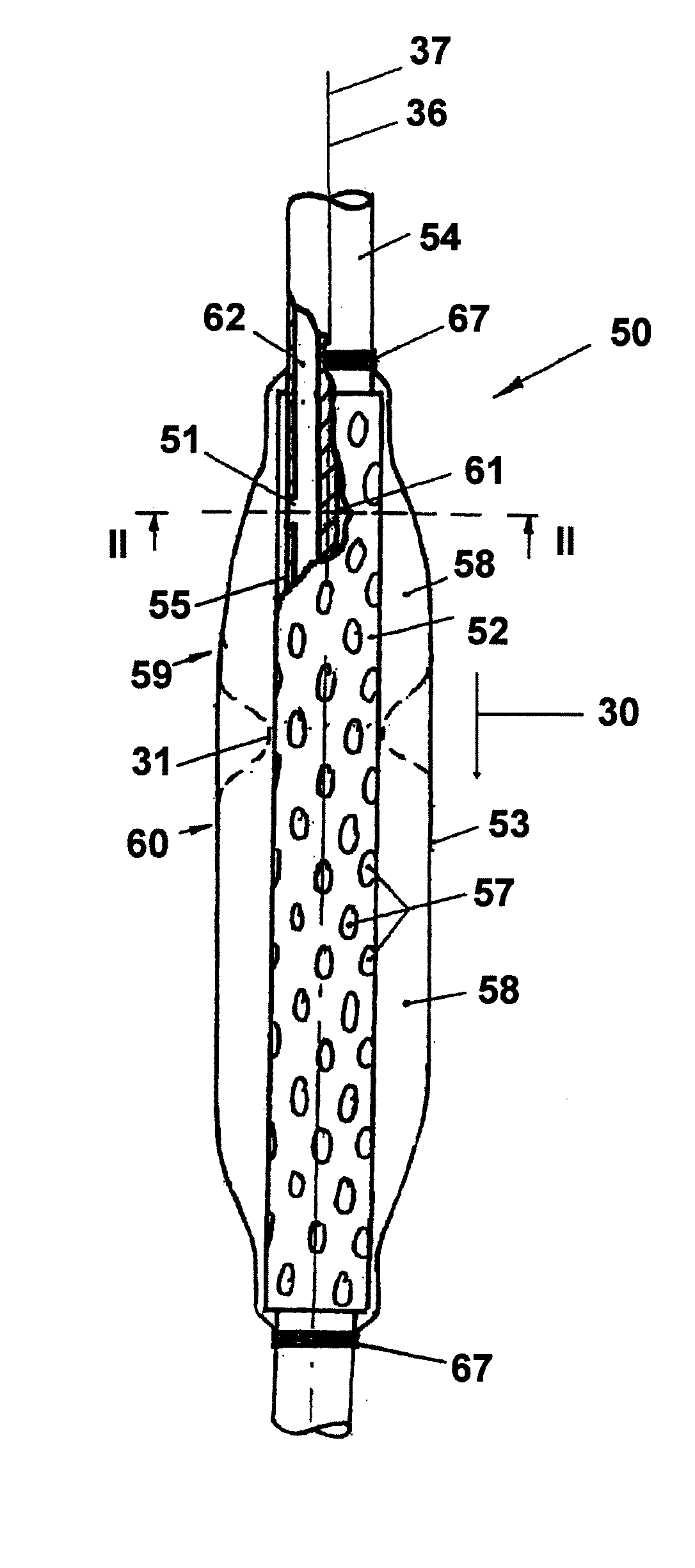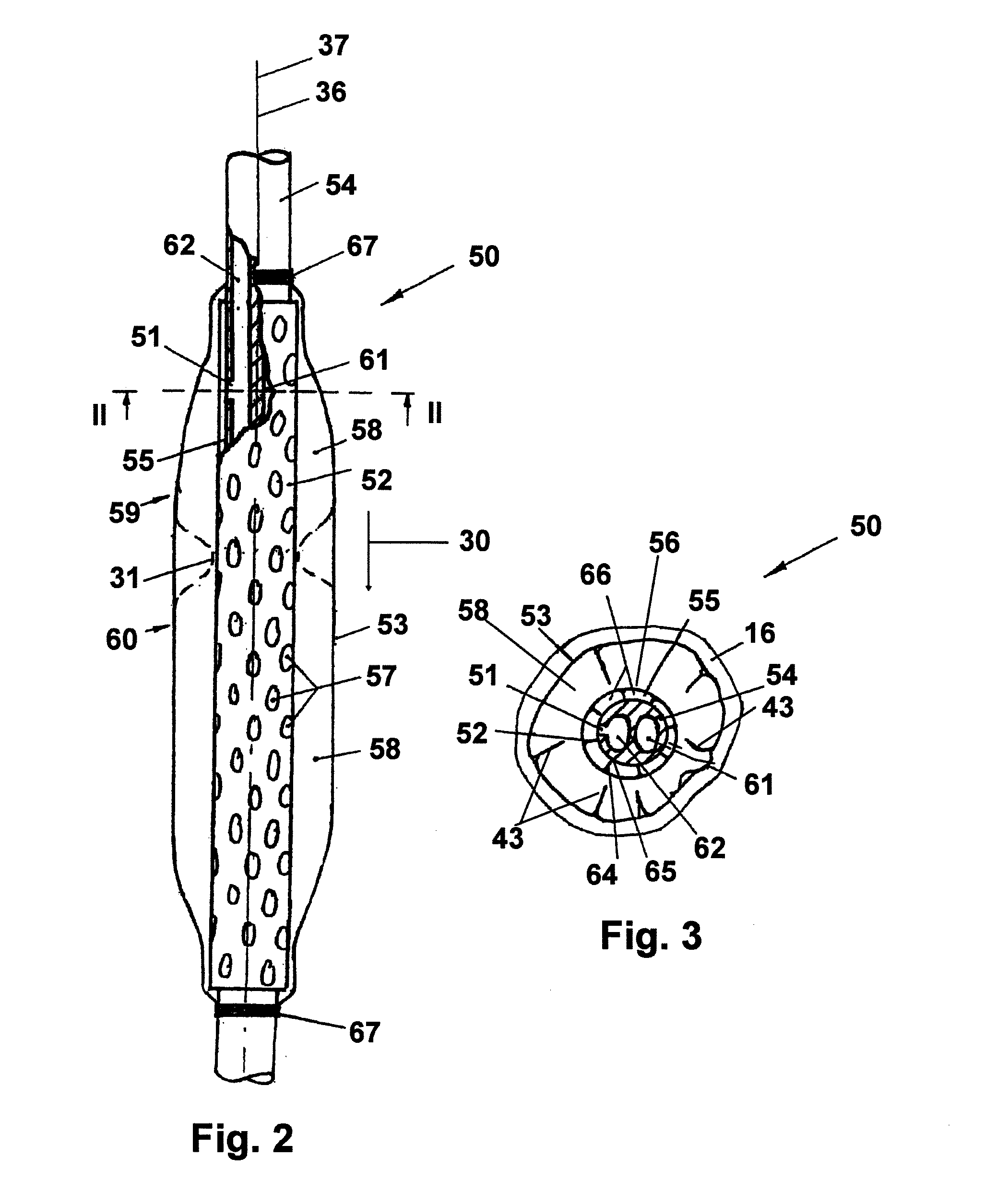[0020]The present disclosure rectifies the disadvantages associated with conventional gastric or duodenal decompression and feeding catheters. The present disclosure includes a decompression or feeding probe that enables a clinician to close off or seal a patient's esophagus over extended periods well in excess of eight consecutive hours, without causing patient
irritation and without causing deleterious effects on the esophageal structures. By interrupting the free communication between the gastro-intestinal tract and the upper
respiratory tract, gastro
esophageal reflux of stomach contents into the pharynx can be reduced. Thus, the
efficacy of gastro-duodenal application of feeding solution can be improved, and the amount of
bacterial colonization of the pharynx and the adjunct cranio-facial cavities can be lowered.
[0021]In one aspect of the disclosure, a
pressure sensor element placed inside the stomach continuously senses intra-gastric pressure and reports to a control device / unit that accordingly regulates the filling pressure of an esophageal placed organ sealing bladder. In one mode, the control device / unit regulates the filling pressure of the esophageal placed organ sealing bladder according to a pressure that is manually set at a predetermined
constant pressure. This is the manually set and operated
stationary mode. In another mode, the control device / unit regulates the filling pressure of the esophageal placed organ sealing bladder according to a pressure that is constantly changing and that is the pressure measured by a second
pressure sensor placed in the esophagus. This is the self-regulated or dynamical mode. Each mode enables the setting of a user determined continuous seal pressure gradient by which the pressure in the esophageal seal bladder exceeds the intra-gastric pressure, thereby effecting a pressure gradient that serves a reflux-preventive esophageal seal function against gastro-
intestinal contents ascending from the stomach past the esophageal seal bladder.
[0022]The control device / unit can be connected or integrated into a feeding pump that delivers the feeding solution to the patient. Such integration enables the above described regulation of a pressure gradient-based esophageal seal function, preventing especially the ascension and loss of pharyngeal feeding fluid into the pharynx, as well as creating a pressure gradient between the stomach and the
duodenum, facilitating the spontaneous emptying of the stomach and intestinal directed flow of feeding solution. The combination of seal
pressure control device and feeding pump provides the ideal tool for the user not only for improving the
efficacy of enteral feeding, but also, reducing the amount of GER in the periods intermittent of gastric feeding, thus having a preventive effect on the development of VAP. Further, the feeding pump unit can integrate special control algorithms that improve the intestinally directed uptake of feeding solution and reduce potential traumatic effects of a permanently exposed seal force on the
pressure sensitive esophageal structures.
[0023]Additionally, a particular oro / naso-gastric / duodenal
catheter design for
combined use with the above described control device or control device / pump combination is described. The
catheter can be provided with a lumen, which is located between the delivery cannula and an
inflatable tampooning esophageal bladder and which is connected to the interior of the
inflatable bladder. The
catheter can be produced by a relatively simple technique, and at the same time guarantees adequate volume
equalization between the partial volumes of the
inflatable bladder. The catheter desirably includes: a tube having at least a double lumen, a gastric
pressure sensor element and an esophageal tampon bladder, whereby the gastric pressure sensor and the tampooning esophageal bladder are connected to a
pressure sensing and regulating control-device. The esophageal bladder can be pre-shaped to a residually dimensioned preformed
diameter that includes a plurality of pleats that can intermesh with the mucosal folding of a patient's esophagus. In this way, in order to effect a sufficient seal of an expanding esophageal lumen, the pleated wall of the tampon bladder need not be stretched by increasing the
internal pressure, but rather merely unfolds at the same pressure and can therefore resize itself sufficiently to cover the physiologic axially directed folding of the
esophageal mucosa at the lowest possible filling pressure. This unfolding mechanism essentially effects a
tamponade of the remaining open lumen in the esophagus, instead of creating a pressure intensive organ blockage, as effected by conventional compliant, expandable bladder materials. Further, the tampon carrying segment of the catheter shaft may be equipped with a special shaft profile, enabling the esophageal placed tampon to withstand peristaltic contractions by performing an intra-tampon volume shift of the applied filling medium from the portion distal of the peristaltic contraction into the portion proximal and already released of the peristaltic contraction.
[0024]In another aspect, the present invention relates to a method or process for effectively reducing gastric reflux into a patient's esophagus. The method involves: providing an enteral
feeding tube having at least a double lumen, an esophageal seal bladder and a gastric pressure sensor element (e.g., gastric
balloon); inserting said enteral
feeding tube into said patient's upper alimentary canal, to position said gastric
balloon in said patient's stomach and said esophageal bladder in said patient's esophagus; receiving from the gastric pressure sensor element an intra-gastric pressure
signal that can be averaged using a
filter algorithm; setting of a user determined gradient value that is continuously added to the sensed actual gastric pressure, thereby defining a relative level of esophageal pressure that should be applied to seal the esophagus from gastro-pharyngeal reflux, respectively enabling the built-up of a pressure gradient directed from the stomach towards the
duodenum, facilitating the emptying of the stomach contents into the distal
digestive tract.
 Login to View More
Login to View More  Login to View More
Login to View More 


